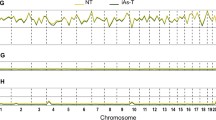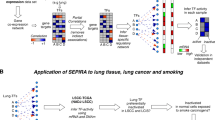Abstract
Arsenic is an established human carcinogen, but the mechanisms through which it contributes to for instance lung cancer development are still unclear. As arsenic is methylated during its metabolism, it may interfere with the DNA methylation process, and is therefore considered to be an epigenetic carcinogen. In the present study, we hypothesize that arsenic is able to induce DNA methylation changes, which lead to changes in specific gene expression, in pathways associated with lung cancer promotion and progression. A549 human adenocarcinoma lung cells were exposed to a low (0.08 µM), intermediate (0.4 µM) and high (2 µM) concentration of sodium arsenite for 1, 2 and 8 weeks. DNA was isolated for whole-genome DNA methylation analyses using NimbleGen 2.1 M deluxe promoter arrays. In addition, RNA was isolated for whole-genome transcriptomic analysis using Affymetrix microarrays. Arsenic modulated DNA methylation and expression levels of hundreds of genes in a dose-dependent and time-dependent manner. By combining whole-genome DNA methylation and gene expression data with possibly involved transcription factors, a large molecular interaction network was created based on transcription factor-target gene pairs, consisting of 216 genes. A tumor protein p53 (TP53) subnetwork was identified, showing the interactions of TP53 with other genes affected by arsenic. Furthermore, multiple other new genes were discovered showing altered DNA methylation and gene expression. In particular, arsenic modulated genes which function as transcription factor, thereby affecting target genes which are known to play a role in lung cancer promotion and progression.


Similar content being viewed by others
References
Azuma K et al (2012) NDRG1/Cap43/Drg-1 may predict tumor angiogenesis and poor outcome in patients with lung cancer. J Thorac Oncol 7(5):779–789
Baccarelli A et al (2009) Epigenetics and environmental chemicals. Curr Opin Pediatr 21(2):243–251
Bieging KT et al (2014) Unravelling mechanisms of p53-mediated tumour suppression. Nat Rev Cancer 14(5):359–370
Boellmann F et al (2010) Genome-wide analysis of DNA methylation and gene expression changes in the mouse lung following subchronic arsenate exposure. Toxicol Sci 117(2):404–417
Bustaffa E et al (2014) Genotoxic and epigenetic mechanisms in arsenic carcinogenicity. Arch toxicol
Cavigelli M et al (1996) The tumor promoter arsenite stimulates AP-1 activity by inhibiting a JNK phosphatase. EMBO J 15(22):6269–6279
Chang YS et al (2002) Correlation between insulin-like growth factor-binding protein-3 promoter methylation and prognosis of patients with stage I non-small cell lung cancer. Clin Cancer Res 8(12):3669–3675
Chitale D et al (2009) An integrated genomic analysis of lung cancer reveals loss of DUSP4 in EGFR-mutant tumors. Oncogene 28(31):2773–2783
Cline MS et al (2007) Integration of biological networks and gene expression data using Cytoscape. Nat Protoc 2(10):2366–2382
Cui X et al (2006) Chronic oral exposure to inorganic arsenate interferes with methylation status of p16INK4a and RASSF1A and induces lung cancer in A/J mice. Toxicol Sci 91(2):372–381
Dai M et al (2005) Evolving gene/transcript definitions significantly alter the interpretation of GeneChip data. Nucleic Acids Res 33(20):e175
Davis AP et al (2013) The comparative toxicogenomics database: update 2013. Nucleic Acids Res 41(D1):D1104–D1114
Eckhardt F et al (2006) DNA methylation profiling of human chromosomes 6, 20 and 22. Nat Genet 38(12):1378–1385
Gautier L et al (2004) Affy–analysis of Affymetrix GeneChip data at the probe level. Bioinformatics 20(3):307–315
Gentleman RC et al (2004) Bioconductor: open software development for computational biology and bioinformatics. Genome Biol 5(10):R80
Guilleret I et al (2002) Hypermethylation of the human telomerase catalytic subunit (hTERT) gene correlates with telomerase activity. Int J Cancer 101(4):335–341
IARC (1987) Overall evaluations of carcinogenicity: an updating of IARC Monographs volumes 1 to 42. In: IARC Monogr Eval Carcinog Risks Hum Suppl, 1–440
Jennen DG et al (2010) Comparison of HepG2 and HepaRG by whole-genome gene expression analysis for the purpose of chemical hazard identification. Toxicol Sci 115(1):66–79
Levin WJ et al (1995) Expression patterns of immediate early transcription factors in human non-small cell lung cancer. The lung cancer study group. Oncogene 11(7):1261–1269
Lisanti S et al (2012) Standardization and quality controls for the methylated DNA immunoprecipitation technique. Epigenetics 7(6):1–11
Liu J et al (2006) Further studies on aberrant gene expression associated with arsenic-induced malignant transformation in rat liver TRL1215 cells. Toxicol Appl Pharmacol 216(3):407–415
Mass MJ et al (1997) Arsenic alters cytosine methylation patterns of the promoter of the tumor suppressor gene p53 in human lung cells: a model for a mechanism of carcinogenesis. Mutat Res 386(3):263–277
Massion PP et al (2003) Significance of p63 amplification and overexpression in lung cancer development and prognosis. Cancer Res 63(21):7113–7121
Maunakea AK et al (2010) Conserved role of intragenic DNA methylation in regulating alternative promoters. Nature 466(7303):253–257
Melotte V et al (2010) The N-myc downstream regulated gene (NDRG) family: diverse functions, multiple applications. FASEB J 24(11):4153–4166
Meno SR et al (2009) Exposure to monomethylarsonous acid (MMA(III)) leads to altered selenoprotein synthesis in a primary human lung cell model. Toxicol Appl Pharmacol 239(2):130–136
Mo J et al (2009) Elevated human telomerase reverse transcriptase gene expression in blood cells associated with chronic arsenic exposure in Inner Mongolia China. Environ Health Perspect 117(3):354–360
Obe G et al (1992) DNA double-strand breaks induced by sparsely ionizing radiation and endonucleases as critical lesions for cell death, chromosomal aberrations, mutations and oncogenic transformation. Mutagenesis 7(1):3–12
Oliveros JC (2007) VENNY. An interactive tool for comparing lists with Venn Diagrams
Pogribny IP et al (1995) Differential sensitivity to loss of cytosine methyl groups within the hepatic p53 gene of folate/methyl deficient rats. Carcinogenesis 16(11):2863–2867
Putila JJ et al (2011) Association of arsenic exposure with lung cancer incidence rates in the United States. PLoS One 6(10):e25886
Reich M et al (2006) GenePattern 2.0. Nat Genet 38(5):500–501
Ren X et al (2011) An emerging role for epigenetic dysregulation in arsenic toxicity and carcinogenesis. Environ Health Perspect 119(1):11–19
Rubporn A et al (2009) Comparative proteomic analysis of lung cancer cell line and lung fibroblast cell line. Cancer Genomics Proteomics 6(4):229–237
Selenius M et al (2008) Treatment of lung cancer cells with cytotoxic levels of sodium selenite: effects on the thioredoxin system. Biochem Pharmacol 75(11):2092–2099
Shivapurkar N et al (2002a) Loss of expression of death-inducing signaling complex (DISC) components in lung cancer cell lines and the influence of MYC amplification. Oncogene 21(55):8510–8514
Shivapurkar N et al (2002b) Differential inactivation of caspase-8 in lung cancers. Cancer Biol Ther 1(1):65–69
Smeester L et al (2011) Epigenetic changes in individuals with arsenicosis. Chem Res Toxicol 24(2):165–167
Smyth GK (2005) Limma: linear models for microarray data. In: R. Gentleman VC, S. Dudoit, R. Irizarry, W. Huber (ed) Bioinformatics and Computational Biology Solutions using R and Bioconductor, Springer, New York, pp pages
Tapio S et al (2006) Arsenic in the aetiology of cancer. Mutat Res 612(3):215–246
Tchounwou PB et al (2003) Carcinogenic and systemic health effects associated with arsenic exposure–a critical review. Toxicol Pathol 31(6):575–588
Team RDC (2011) R: A language and environment for statistical computing. R Foundation for Statistical Computing. URL http://www.R-project.org/. Vienna, Austria
Wagner JR et al (2014) The relationship between DNA methylation, genetic and expression inter-individual variation in untransformed human fibroblasts. Genome Biol 15(2):R37
Weber M et al (2005) Chromosome-wide and promoter-specific analyses identify sites of differential DNA methylation in normal and transformed human cells. Nat Genet 37(8):853–862
Weber M et al (2007) Distribution, silencing potential and evolutionary impact of promoter DNA methylation in the human genome. Nat Genet 39(4):457–466
Woodson K et al (2001) Hypomethylation of p53 in peripheral blood DNA is associated with the development of lung cancer. Cancer Epidemiol Biomarkers Prev 10(1):69–74
Young MD et al (2011) ChIP-seq analysis reveals distinct H3K27me3 profiles that correlate with transcriptional activity. Nucleic Acids Res 39(17):7415–7427
Zhang AH et al (2011) Relationship between the methylation and mutation of p53 gene and endemic arsenism caused by coal-burning. Zhonghua yu fang yi xue za zhi Chinese journal of preventive medicine 45(5): 393–398
Zhou P et al (2005) Changes in gene expression profiles of multiple myeloma cells induced by arsenic trioxide (ATO): possible mechanisms to explain ATO resistance in vivo. Br J Haematol 128(5):636–644
Zhou X et al (2008) Arsenite alters global histone H3 methylation. Carcinogenesis 29(9):1831–1836
Zhu J et al (2003) Arsenic trioxide induces apoptosis in leukemia/lymphoma cell lines via the CD95/CD95L system. Oncol Rep 10(3):705–709
Conflict of interest
The authors declare no conflicts of interest.
Author information
Authors and Affiliations
Corresponding author
Electronic supplementary material
Below is the link to the electronic supplementary material.
Rights and permissions
About this article
Cite this article
van Breda, S.G.J., Claessen, S.M.H., Lo, K. et al. Epigenetic mechanisms underlying arsenic-associated lung carcinogenesis. Arch Toxicol 89, 1959–1969 (2015). https://doi.org/10.1007/s00204-014-1351-2
Received:
Accepted:
Published:
Issue Date:
DOI: https://doi.org/10.1007/s00204-014-1351-2




